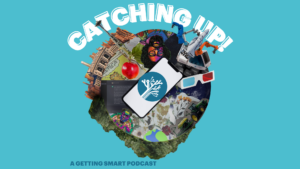Building on the Power of Digital Badges to Create Future-Ready Learning and Job Experiences for Students

By Connie Yowell. This post was originally published on Medium.
Take a moment to envision what the future of learning and work will look like in the next 10 to 20 years. Do you see the current model of education and business existing as we know it today? Perhaps some elements will remain the same but almost everyone will agree there must, and will be, changes to the way students learn and the way work takes place. One of the trends that have been preparing us for the future of learning and work over the past six years is digital badging.
The field began to realize the power digital badges could have in 2011. At that time, I was working on the Open Badges project at John D. and Catherine T. MacArthur Foundation and one of our grantees, the Mozilla Foundation started to mobilize the Open Badge movement. The purpose of the badge was to have a visual representation of the skills and achievements a learner possessed, which were grounded in verifiable data and evidence and could move across the learner’s platforms and networks thereby empowering them not only to take charge of their own learning but also highlight the learning journey.
Over the next five years, we continued to unpack the impact personalized learning experiences, such as badging, could have on learners and the education system. Digital badges demonstrated they had potential by enabling much greater flexibility in designing personalized learning experiences and allowing individuals to earn them in a wide variety of learning environments after demonstrating competency. Knowledge and skill development and recognition of learning no longer had to take place solely in a classroom setting. This also meant that we needed to ensure two things:
- That compelling educational content could exist in these flexible formats.
- The field saw the value of learning (and thereby the badge) in these environments.
In 2015 there was a notable development with the rise of micro-credentials, especially for educators. Micro-credentials allow educators to take charge of their own professional development by demonstrating their knowledge on a subject through evidence which then leads to earning a credential (and a badge) that can be displayed in a digital portfolio and social networks. Micro-credentials for educators have been powerful for several reasons but two, in particular, stand out:
- This form of learning has challenged the traditional notion of “sits and gets” professional development. Instead, educators are able to curate their own learning and demonstrate it to earn a credential, all driven by what they are most interested in.
- With educators experiencing this transformation in the learning process, it is somewhat easier to see, and then design for, a similar learning experience for students.
In 2016 we saw a shift in the community as the Badging Alliance became part of IMS Global Learning Consortium, and effective in January 2017 IMS Global “assumed the responsibility to lead the evolution of the Open Badges specification and to ensure the sustainability of the future Open Badges ecosystem.” Also in 2017, we saw a resurgence of badging as a learning strategy especially in the context of the future of learning and the future of work. This energy has continued in the first months of 2018 and it’s all for good reason: we know that digital badges are a game changer.
Badges open up a world of learning that many students previously did not have access to. Through badging students can take their learning outside of the school building, unlocking a world where they can learn skills that are of greatest interest to them or their future career, at a time and place that best suits their needs. Once the skill has been mastered it is captured in a badge which can be viewed in a digital portfolio that schools and potential employers can see.
This means that the traditional transcript, issued based on traditional modes of learning, is no longer the only way that skills and knowledge can be displayed. This flexibility in learning is not only important from a student’s standpoint but also from the standpoint of future employers. Take for example a 2016 Pew Research Center and Elon’s Imagining the Internet Center canvassing on the “The Future of Jobs and Jobs Training” which found that experts believe new credentialing systems will arise as self-directed learning continues to expand.
What’s more is that according to those canvassed, while college degrees will still have importance in 2026, “more employers may accept alternate credentialing systems, as learning options and their measures evolve.” Employers realize traditional models of education are no longer the only way to obtain and demonstrate knowledge, and this increases access and opportunity for more youth to learn through a variety of methods and showcase that knowledge with evidence, such as digital badges.
In 2015 the Association of American Colleges and Universities conducted an online survey of employers and college students and the findings were similar to that of the Pew Research Center study. A key finding of the survey was that “Employers say that, when evaluating a job candidate, it would be helpful for them to have access to an electronic portfolio summarizing and demonstrating the individual’s accomplishments in key skill and knowledge areas, in addition to a résumé and college transcript.”
This history and the amount of change we’ve seen since 2011 is encouraging. LRNG is committed to the power of digital badging. We believe badges have an incredible potential to transform the future of learning and work for every student regardless of their zip code. With LRNG, cities can support youth in unlocking potential jobs, internships, mentorships and learning so those even furthest from opportunity get connected.
For more, see:
- LRNG and Institute for the Future: Helping Youth Get #FutureFit
- A Simple, Free, Powerful Badging System
- Rethinking High School: Badging, Competency-Based and Real-World Work
- Students Earn Digital Badges for Project Management Skills
- Badging for Business: Next-Gen Professional Learning in the Workplace
Stay in-the-know with all things EdTech and innovations in learning by signing up to receive the weekly Smart Update. This post includes mentions of a Getting Smart partner. For a full list of partners, affiliate organizations and all other disclosures, please see our Partner page.





0 Comments
Leave a Comment
Your email address will not be published. All fields are required.